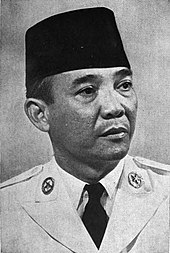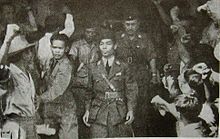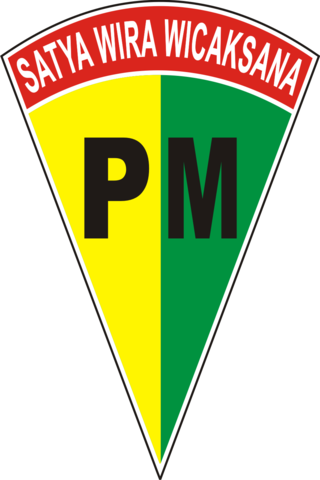Use in Indonesia
Panglima Tertinggi Angkatan Bersenjata Republik Indonesia

As stipulated in article 10 of Indonesian Constitution, the President of Indonesia is the Supreme Commander of Indonesian Armed Forces (Panglima Tertinggi Angkatan Bersenjata Republik Indonesia). [2] Essentially it is parallel to the title 'Commander-in-Chief' in other countries, e.g. the United States.
During the Old Order era, this title is included into many honorific titles that were often mentioned each time Sukarno's name was written or read in speeches, edicts, or news.
Panglima TNI
In Indonesian National Armed Forces the highest position overseeing the three branches - Army, Navy, Air Force - is called Panglima Tentara National Indonesia ('Commander of the Indonesian National Armed Forces'). Before the separation of the National Police from the Armed forces in 2000, the Armed Forces consisted of four branches. The Armed Forces were named Angkatan Bersenjata Republik Indonesia, which comprised TNI and the Police. The commander of the Armed Forces was called Panglima ABRI accordingly, or usually known with the acronym Pangab.
According to the revised Constitution Panglima TNI is appointed by the President after confirmed by DPR. Before the Constitution was amended in 2002, the President had the prerogative right to appoint or dismiss the 'Panglima' at his pleasure.
Panglima Besar

The honorific title Panglima Besar, meaning 'Grand Commander' was bestowed informally upon Sudirman, the first Commander of the Armed Forces and legendary leader of guerilla war during Indonesian National Revolution (1945–1949).
Other military uses
Beside the use for 'Panglima TNI', the title 'Panglima' is also used for many formations within the Armed Forces.

The commander of Kostrad, a formation within the Indonesian Army, is called Panglima Kostrad. One of such notable Panglima Kostrad is the first, Suharto, who later became a President of Indonesia (1968–1998), and the second, Umar Wirahadikusumah, who became Vice President of Indonesia (1983–1988).
Each commander of Regional Military Commands (Komando Daerah Militer, usually known with the acronym Kodam) has the title Panglima Daerah Militer or Pangdam. There are 15 Kodam, each with one Pangdam.
Each commander of the three Fleet Commands is given title 'Panglima'. The commander of the 1st, 2nd and 3rd Fleet Command (Komando Armada I/II/III), are known as Panglima Armada I/II/III or Pangarmada I/II/III.
Similar to the Navy, each commander of the three Air Force Operations Commands is also given title 'Panglima'. The commander of Air Force Operations Command - 1/2/3 (Komando Operasi TNI Angkatan Udara I/II/II or Koopsau I/II/III), are known as Panglima Koopsau I/II/III.
The highest position in Military Sea-lift Command (Komando Lintas Laut Militer / Kolinlamil) are given the title of 'Panglima', which is Panglima Kolinlamil.
Past usage
Upon the formation of the Fourth Working Cabinet (19 November 1963), the title 'Panglima' was used for the commander of each branch of Indonesian Armed Forces. [3] They were also members of the Cabinet. Therefore, they were given the title Menteri (Minister), appointed directly by the President. As such, their titles were:
- Minister/Commander of the Army (Menteri/Panglima Angkatan Darat, abbreviated Menpangad)
- Minister/Commander of the Navy (Menteri/Panglima Angkatan Laut, abbreviated Menpangal)
- Minister/Commander of the Air Force (Menteri/Panglima Angkatan Udara, abbreviated Menpangau)
- Minister/Commander of the Police (Menteri/Panglima Angkatan Kepolisian, abbreviated Menpangak)
This use was discontinued in the New Order era, replaced with the title Kepala Staf (Chief of Staff) for the commander of three branches and Kepala (Chief) for the Chief of National Police.
Prior to January 2022, National Air Defence Forces Command (Komando Pertahanan Udara Nasional / Kohanudnas) also use the title of 'Panglima' for its highest position, which is Panglima Kohanudnas and for its each Commander of Air Defense Sector (Panglima Komando Sektor Pertahanan Udara Nasional or Pangkosek Hanudnas).














